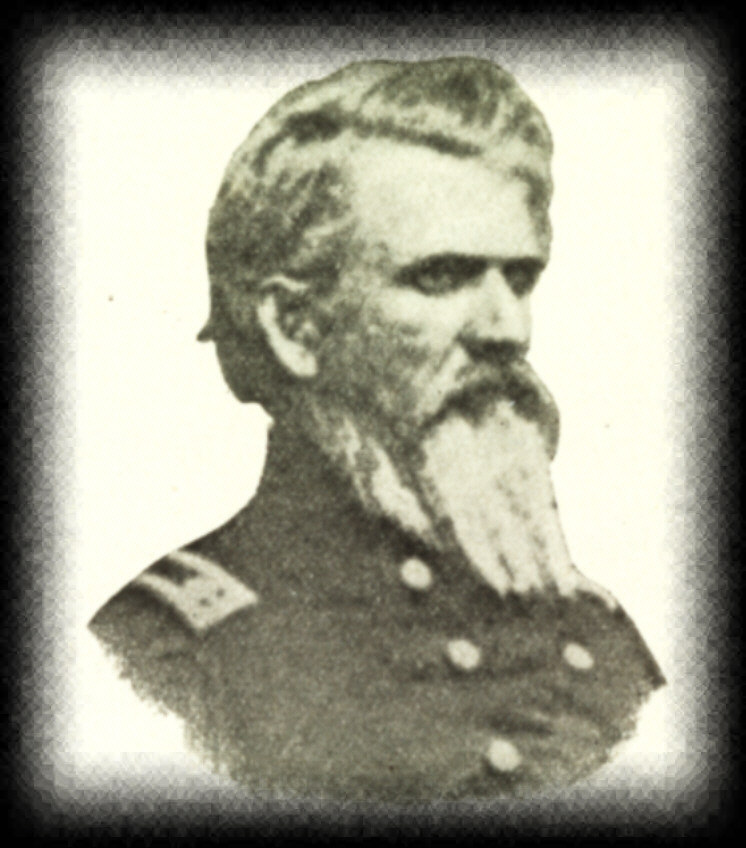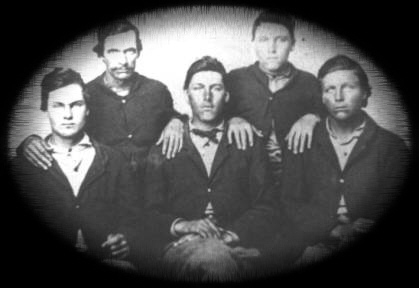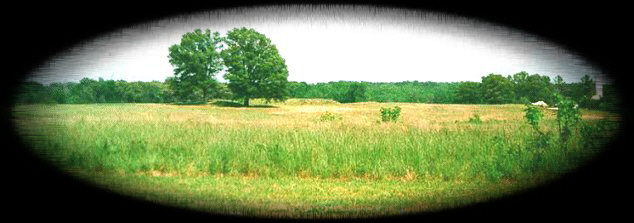The brave, yet sad, war career
of
Pvt. William Stillhammer
Written by:
Mr. Don Sides
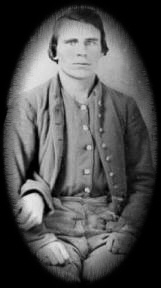
William Stillhammer, Bloomington, Illinois
Company G, 4th Illinois Cavalry, and later Company F, 39th Illinois Volunteer Veteran Infantry. Died April 2, 1865 in one of the last charges of the Civil War
The Stillhammer Story
In April of 1862, a few weeks after surviving the bloody clash at Shiloh, the young, boyish, and even somewhat frail looking William Stillhammer was deathly ill in the hospital in Corinth, Mississippi, of an unknown illness. With time he recovered, and by November he was in Grant’s primary advance cavalry, the 4th Illinois Volunteer Cavalry, on the Mississippi Central Mississippi railroad campaign. Surviving daily and almost hourly clashes with the Confederates for several weeks along the rail line, he then fought in the largest engagement since “Second Corinth” when Union forces met a concentration of Confederates near Coffeeville, on December 5th. As an orderly in Company G, he went unscathed during the main battle, but was wounded in both thighs alongside Lt. Col. William McCullough in a night ambush after the Confederate generals had ordered a cease-fire. Stillhammer managed to escape capture when a friend, P. O. Avery, found and took him up on the back of his horse and then got him to a wagon to return to a makeshift hospital in Water Valley later that night. From there we was sent to the 124th Illinois field hospital outside of Oxford, Mississippi, and later to Holly Springs, then Memphis, and eventually to a hospital in Keokuk, Iowa in February of 1863. There, he spent months recovering from his severe wounds, and was later mustered out of the 4th Illinois Cavalry on November 8, 1863.
Rather than resume a safe and peaceful life in the farm lands of central Illinois, Stillhammer re-enlisted on March 15, 1864 with the 39th Illinois Volunteer Veteran Infantry. After serving under Grant with the 4th Illinois in the western theatre in Mississippi, he would now be sent to fight under Grant in the eastern theatre in Virginia. In 1864, in a fight near Spring Hill, Virginia Stillhammer was listed as missing, later thought dead, but instead was captured following a charge, and held as a prisoner of war. It is assumed he eventually escaped imprisonment and soon re-joined the 39th Illinois Infantry where he continued to participate in the heavy engagements in the east.
As Grant’s superior numbers were decimating the remaining Confederate forces in the Spring of 1865, William Stillhammer was killed in one of the final charges of the Civil War. On April 2, 1865 he was struck down in the charge against Fort Gregg, the last strong hold of Petersburg -- and oddly a charge in which the Federals outnumbered the entrenched Confederates by a margin of 10-1. Seven days later General Lee would surrender at Appomattox Courthouse to end the war.
After four years of devoted service in the Union army, in the most crucial early action in the western theatre, and later the most crucial campaigns in the east, to end the war – suffering through disease, gun shot wounds, near capture, capture and imprisonment, and escape to fight again – William Stillhammer died on the battlefield, a pauper, in the final week of the war. He is most likely buried near Petersburg, Virginia, in a long forgotten and unmarked grave. All of his personal effects were thrown away with his knapsack while making the charge on Fort Gregg, and all that was found in his clothing was one dollar and fifteen cents, along with a few postage stamps. He acquired a pocket watch using his upcoming pay check as security, but once his body was recovered the watch was returned to its previous owner and the company commander later forwarded his devoted mother his last army issued earnings. At the time of his death – after four years of service – Stillhammer’s “estate” consisted of a garnished pocket watch and less than $1.50 in stamps and coins.
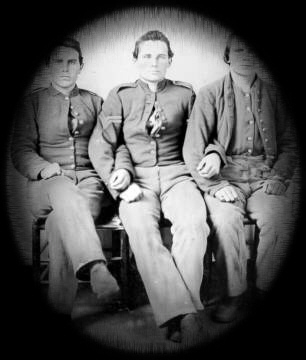
The Stillhammer brothers of Illinois
William is on the far right
More about William Stillhammer
Listed in the Illinois rosters are three other “Stillhammers.”Charles, 2nd Lt., CO. K, 8th Illinois Infantry, McClean County, Henry, Pvt., Co. K, 8th Illinois Infantry, McClean County, and John F., Pvt., Co. F, 106 Illinois Infantry, Logan County.
In my research of the Battle of Coffeeville I have come to “know” quite a few of the soldiers who fought here and enjoy finding out more about these “friends,” and am always delighted to discover new information and insights into them.
One of the most interesting accounts in the Battle of Coffeeville was that of Phineas Orlando Avery and several other Illinois cavalry soldiers. Briefly, Elliott Hyde, 4th Illinois Cavalry, saw a coming Confederate charge and as he jumped up to run he paused to call out to his friend P.O. Avery. He said, “Avery you better get out of here -- the Rebels are flanking us.” Avery looked around and saw no other blue coat in sight –- but he did see the charging Confederates. He wrote that he turned to look at Elliott Hyde and “the instant my eyes caught Elliott’s he threw up his hands and fell over backwards-shot through the brain. The ball entered the left eye; he didn’t utter a word.”
This is an example of the camaraderie of men in battle. Elliott Hyde could have slipped safely through the woods, yet he stopped to warn his friend, and was then seen by the Confederates. In essence, he saved his friend’s life and got killed for doing it.
However, at nightfall, the 4th Illinois Cavalry was ambushed by the 14th Mississippi infantry under major Doss. The 4th Illinois had been ordered back to the “Panola” road, turned to ride as rear guard, and upon entering a hollow they were ambushed in the darkness. Lt. Col. William McCullough was killed, seventeen of his escort were captured, and many others wounded. Among them was William Stillhammer, orderly to McCullough. P.O. Avery states that Stillhammer was wounded in both thighs, but that Avery was able to save him by getting him onto the back of his horse and then into an ambulance. In essence, Elliot Hyde was killed saving the life of P.O. Avery, and because Avery was spared he was then able to help save the life of William Stillhammer.
I had wondered what became of Stillhammer, and had never even seen an image of him. I had no idea of his age, appearance, or subsequent records. The night before the 139th anniversary of the Battle of Coffeeville I stumbled across an image of William and his brothers, and also some very interesting letters. This led to more research and the discovery of additional information by which I was able to piece together a somewhat sketchy, but still fascinating, account of young Stillhammer’s military experiences. I referred back to some previously discovered diaries, primarily those of P.O. Avery and Thomas K Mitchell, both of the 4th Illinois Volunteer Cavalry, and from that, along with the new information, I was able to piece together the following:
(Mitchell) Muster Roll of Co. G 4th Illinois Cavalry, October 30th, 1861.Captain, Harry D. Cook; 1st Lieut. John L. Harper; Sergeants, Elijah H. Baker, Abram Conica, William S. Addington, William R. Bigham, Thomas K. Mitchell, Charles D. Butler; Corporals, Joseph M. Barton, William Ellis, George H. Everett, Thomas Orr, William H. Campbell, Harrison Mooberry, Abel A. Adams, Marshall Montgomery; Bugler, Benjamin W. Canady; Saddler, Aiken D. Hiatt; John M. Davidson and George S. Farnsworth, blacksmiths; Stephen Archer, Wagoner; Privates, Francis M. Archer, Alonzo S. Adams, Hezekiah T. Buckley, Alfred S. Burtis, Joseph Bunk, Carlin Baxter, Jacob Bevin, Warren W. Brown, Jonathan Carrier, John Carber, George W. Carr, Levi Chapman, David M. Cole, Alonzo Cooper, Albert C. Conkling, Harvey Canady, Elisher H. Dixon, Donica Jacob, Henry C. Drum, Danaiel C. Durkee, Valentine Denning, William B. Elliott, Hahum A. Elkins, John Feltman, Philip H. Faright, Thomas B. Faright, Barton Goodrich Horace H. Harris, Gideon R. Hawkins, David I. Horn, William H. Harrison, Benjamin Hull, Isaac H. Hood, Henry Horn, Wesley Hibbs, John Herr, Andrew I. Hatton, James E. Johnson, Charles W. Jones, Mark I. Kingsburg, Samauel Kuhn, Frederick Martin, Barney Manning, Frank Montgomery, Shelton F. Martin, James M. Martin, William O’Hare Patrick O'Brien, Charles W. Patterson, Thomas Porch, John Painter, William M. Pitter, Henry Robins, Thomas Saul, John W. Simpson, John W. Skinner, William Stillhammer, John W. Taylor, Hanson Tuesburg, Spencer A. Vanderbilt, David Welback, Abram Wilson, William Walton, Henry M. Woodsides, Benjamin S. Whiting.
Following the Battle of Shiloh on April 6-7, 1862 – the first major bloody clash of large armies in the west – Union forces moved south and occupied Corinth, Mississippi. Many recovered from their Shiloh wounds there, and others recovered from other illnesses – one of the most widespread being the potentially deadly dysentery that is mentioned often during this time in Union accounts.
(Mitchell) “May 27th — Midnight, at the hospital. I am here taking care of the sick. There are four patients. Three of them, our boys, Baker, Mooberry and Stillhammer. The last two are quite sick. They are now all-asleep and nothing is heard, save once in awhile, the shrill whistle of a Locomotive at or near Corinth, and now and then the sharp crack of a rifle fired by some of the picket guard.”
Stillhammer obviously made a full recovery, and by early November was in Grant’s primary advance cavalry moving south down the Mississippi Central Railroad. There were clashes along the rail line above and in Holly Springs, Lumpkins Mill, more significantly in Abbeville, then in Oxford, and Water Valley. The Federals pushed almost at will with no legitimate chance of being halted – until December 5th above the small village of Coffeeville. Here, the Confederates were bottle-necking through town by the thousands on their way to meet General John C. Pemberton to prepare defense lines on the Yalobusha River, just north of Grenada, in preparation for what both sides thought would be a major clash on the scale of another Shiloh.
The Battle of Coffeeville was the first time that Grant’s men had ever been “put on the run” and “kept on the run.” The battle had turned into a Confederate route within the first 30 minutes, and once Grant’s forces began their retreat the Confederates pressed them hard. Late in the afternoon CSA Major Doss had moved to the far eastern flank, adding to the extremely heavy Confederate fire as the battle was closing. The cease-fire by Tilghman had been generally ignored and this led to the ambush of the 4th Illinois cavalry by Doss and the 14th Mississippi Infantry.
As dusk fell, Doss had swung far to the east, out of the site of the Federals, and now moved his men along a ridge that effectively screened their movements. He followed the east side of this ridge and then followed the terrain back to the west where the hollow divided into two valleys. Both led to the back door of the Federal retreat. The Federals were aware that the Rebels had not quit their pursuit, and Dickey ordered a detachment to serve as rear guard for his retreating cavalry, sending Lt. Col. McCullough with a relatively small party to check any Rebel advances.
(Mitchell. Water Valley.) “December 5th — Camp same place. Came upon the enemy today, 6 miles from Water Valley, and 5 miles north of Coffeeville. Skirmish some and drove them about 3 miles, when we run into a strong force of the enemy’s infantry and Artillery. Had quite a fight. Finding them too strong for us we were ordered to fall back. Co. “G” was put out as flankers on the right and rear. As soon as we began to retreat the Reb’s came on us with a heavy force, on double quick. We had a brisk little fight and fell back about a mile, rather fast for good order, then retreated to this place, got here at 11 o’clock. As the last fight was just at dark I do not know all the particulars. Ordered to march at 2 o’clock. Frosty and cool.”
(P. O. Avery) "It was now getting quite dark. There was now a call for volunteers to go back toward the front and form another line. About fifty of us went…Shortly afterwards everything was on the move to the rear and we were called in and mounted. Our regiment, Lieutenant Colonel McCullough commanding, was to be rear guard and was just moving out when they ran into a force of the enemy's infantry that had been sent up along our flank and had got across our road between the column and the rear guard.”
(Unknown Illinois soldier account.) “Darkness soon sat in and Col. McCullough received information that the enemy was flanking us. Our regt fell back about the road and had not gone far before we were fired upon from our right flank. Col McCullough fell mortally wounded. He was riding at the head of his column and was ordered to halt by the enemy. He at first thought them our own men. His first wounded in the right leg. He then began to dismount and was shot twice more and killed. By this time the enemies whole line was a blaze of fire aimed right at the head of our column of only parts of four companies.”
(P. O. Avery) “The rebels fired into the head of our column, killing Lieutenant Colonel McCullough and wounding several others. John Lansing of Company I, who was the Colonel's orderly, is crippled for life by a fall from his horse. Wm. Stillhamer, another orderly from Company G, was shot in both thighs. I took the latter off the field on my horse and after going several miles in this way I got him into an ambulance."
(Mitchell) “December 6th — Camp, 15 miles Southwest of Oxford, on a farm where there is plenty of corn and hogs. Col. McCullough was killed in the fight last night, while at the head of the Reg. Wm. Stillhammer of our Co. was badly wounded, John Herr slightly. A flag of truce party went back to the battleground today and found the bodies of Col. McCullough and three men, and buried them there. They saw no enemy. My horse was shot in the thigh last night. Took the ball out today. Reported now that the rebels are in force at Grenada and that a force of ours is on the railroad farther south. Our infantry is at Oxford. Our Co. teams are there and our rations farther back. We need rations badly. Have corn meal, potatoes and Fresh pork today. No pots to cook in. Everett and I will sleep in a cotton house tonight.”
Dwight Allen Brown, a fellow 4th Illinois cavalryman, was also wounded in this ambush. He recorded that he also escaped capture and returned to Water Valley by wagon where he was taken to a makeshift Federal hospital, and then to the 124th Illinois field hospital outside of Oxford, Mississippi, then to Holly Springs, Memphis, and eventually to Keokuk, Iowa. It is a near certainty that William Stillhammer made these transfers with Brown.
(Mitchell) “February 28th—Muster for pay. Capt. Cook is yet at Trenton. H. Horn and D.M. Cole are at Brigade Head Quarters. Marti and Stillhammer, in Hospital at Keokuk Iowa. The men taken prisoners at Trenton are at St. Louis. T.W. Ramsey has been unwell for several days. He is now in the hospital and is quite sick with Typhoid.”
(Mitchell) List of men discharged from Company “G”, 4th Illinois Cavalry.
Benjamin W. Canady, June 20th, 1862.
Daniel O. Durkee, Frank Montgomery, Abel A. Adams, Valentine Denning, Stanford B. Saltsman, William s. addington, Warren W. Brown, Barney Manning, William B. Elliott, Frederick Martin, Thomas B. Faught (veteran), all under general order No. 14.
David I. Horn, June 20th, 1862.
Edwin Sessions, July 26th, 1862.
George S. Farnsworth, August 9th, 1862
William M. Ritter, October 14th, 1862.
John Y. Walston, November 4th, 1862.
Charles D. Butler, November 21th, 1862.
John Feltman, March 18th, 1863.
George Franklin, March 18th, 1863.
Albert M. Montgomery, April 6th, 1863.
Thomas W. Ramsey, April 13th, 1863.
William Stillhammer, November 8th, 1863.
Stephen Archer, November 8th, 1863.
Thomas Porch, December 8th, 1863.
David Hand, February 6th, 1864.
Albert c. Conkling, March 15th, 1864.
Charles Luce, August 1st, 1864.
Lewis C. Kimler, September 17th, 1864.
Isaac B. Beam, October 10th, 1864.
Friends of William Stillhammer during his days in Company "G", 4th Illinois Cavalry
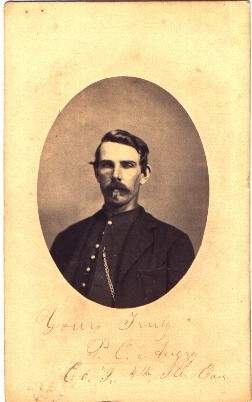
Phineas Orlando Avery
Helped save Stillhammer in the night ambush following the Battle of Coffeeville by taking him up on his horse and later getting him into a wagon to safety.
“Wm. Stillhamer, another orderly from Company G, was shot in both thighs. I took the latter off the field on my horse and after going several miles in this way I got him into an ambulance.”
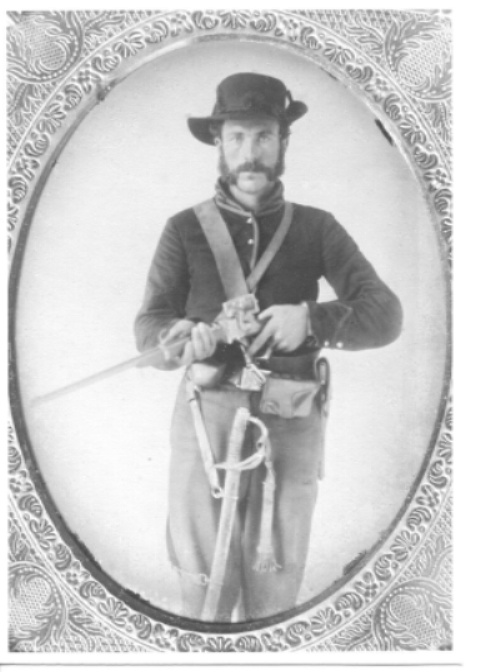
Dwight Allen Brown, Company "M", 4th Illinois Volunteer Cavalry
“All the men riding white horses were either killed or wounded.”
Wounded alongside Stillhammer in the night ambush. It seems evident that both were taken to a Federal hospital in Water Valley that night, and eventually to Keokuk, Iowa to covalence.
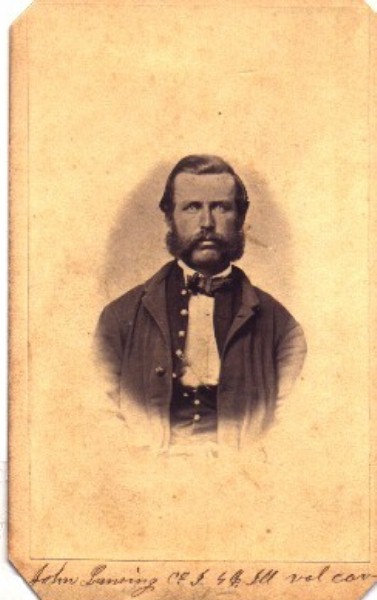
Pvt. John Lansing
Another orderly shot alongside Stillhammer in the ambush. Crippled for life from the fall of his horse
Lt. Col. William McCullough
Killed in the night ambush
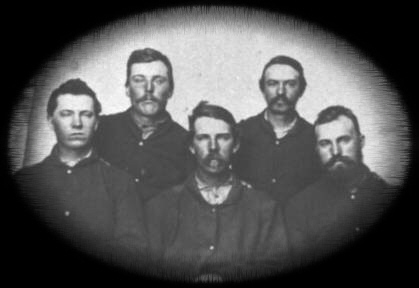
4th Illinois Cavalrymen
Henry Preston, William Wead, Phineas O. Avery, Charles Munnikhui, and Ottis Halstead
Andrew J. Norton, Henry J. Grundy, Sam Carter, Joseph Carter, Alexander Norton
*******
I had assumed this ended the military career of the young William Stillhammer. Yet, it appears certain he re-enlisted on March 15, 1864 with the 39th Illinois Volunteer Veteran Infantry, and was then sent to the eastern theatre, again under Grant, to participate in the major engagements there that would end the war.
Here is the first of two interesting letters about his continuing tribulations. Although the commanding officer will not state that he believes Stillhammer died in battle, the reader can certainly surmise that the officer believed this to be probable, especially when he closes by saying “…yours in affliction…”
Spring Hill, Virginia
June 18, 1864
Mrs. Stillhammer,
I have the honor to give you all the information concerning your son. (?) That he was with the company I command during the fight on the 16th day of May. I advanced a line of skirmirshers through the woods and met with the enemy in force. Some of the men were wounded, others missing, and your son was amongst the missing. Further I can only (conjecture ?) to his fate though. I hope and trust he is not hurt and at some future time again return to your presence. During the brief time he was under my command he has shown himself willing and obedient as a soldier, warm hearted as a friend, brave, almost to a fault, and should it prove the worst, that of death, (our ?) consolation he (was ?) boldly facing the foes of our honor and our much respected country. I cincerely sympathize with your affliction and bereavement though more for him not as (?) he may yet return such is my humble prayer and (if Him that ruleth hath not so ascribed ?) let us show with humility and prepare to meet the throngs gone before to that place of rest from whence none return.
Believe me, to be yours in affliction,
A.B. Hoffman
Captain of 3rd regiment
39th Illinois infantry
In fact, it is almost certain that Stillhammer was taken prisoner during this fight, as evidenced in the letter below. It is not known how or where he re-appeared, or of his experiences. It does, however, appear likely that he escaped, re-joined his unit, and saw several more months of combat in 1864, and then continued fighting almost until the end of the war in April of 1865.
The next known letter is dated by Captain R. S. Bottsford after the war had ended. It is obviously in response to Mrs. Stillhammer’s request concerning her son’s well-being and an unknown personal belonging that is vaguely referred to. Two weeks after Lee surrendered at Appomattox the following letter was sent home to Mrs. Stillhammer. Imagine, in that day, after reading the late published newspaper accounts that the war was finally over, hearing about -- and experiencing the local celebrations in Illinois-- waiting in anticipation for “the boys to come home” … and then receiving this letter:
Company F, 39th Regiment
Richmond, Virginia
April 27, 1865
Mrs. Stilheimer
Bloomington, Ill.
Dear Madam,
I have the painful duty to perform of writing you concerning the death of your son, Wm. Stilheimer, of my Co.
He had but recently returned to his company from absence as a prisoner of war. He had said to some one of the company that he never would be a prisoner of war again – how much this sentiment has to do with his death I know not but know that he fell while heroically battling for his country. Before leaving the north side of the James River I thought enough of him to appoint him as corporal in the company. This I think will be sufficient to inform you of his ability and esteem in which his character was held by his comrades. I sincerely sympathize with you in the loss of so noble a son if it can be possible. In making the charge on Fort Gregg Petersburg (the key to Richmond and Petersburg) the men were ordered to throw away their knapsacks if it became burdensome in double quicking so far or possibly it might have been on his person and lost in this manner as I can obtain no clue to it (?). In his pocket was one dollar 15/100 with a few postage stamps which I enclose to you all of the effects that I have except a watch he had given his note for, payable next government pay day which I will also enclose considering that the money would be of more service to you than a watch. The watch is bestowed to the owner. It is the final settlement of his service to with the government (?) I can be of any further service to you I will cheerfully assist.
Very respectfully,
Your obedient servant,
R. S. Bottsford
Captain 39thIllinois infantry.
It is unknown where Colonel William Stillhammer is buried More on the fascinating war career of William Stillhammer
The Charge at Fort Gregg
Fort Gregg
William Stillhammer’s final charge was made at Fort Gregg, and it may have been here on this field that he lost his life. Oddly, he and his comrades outnumbered the Confederates 10-1, as Petersburg and the Confederacy were at the point of final collapse.
Pictured here is Fort Gregg as seen from the perspective of Gibbon's XXIV Corps which came upon it at one o'clock on its way to Petersburg. The Boydton Plank Road leading into Petersburg is near the white towers on the right of the picture. Fort Gregg and Fort Whitworth, which is off the picture to the left and on private property, were built in front of Petersburg's western defenses specifically for the purpose they would now serve. Petersburg's western defenses in the picture were in the trees on the horizon. Since Wright's VI Corps had moved southwest after its breakthrough to clear the whole line, Longstreet's men had time to begin moving into the western defenses. Brigadier Gen. Lane's men were first to reach the forts, but when Harris's brigade approached, some of them were also sent into the forts. In all, 214 men defended Fort Gregg, and they would be outnumbered ten to one by their attackers.
After a half hour bombardment, the assault began. The defenders of Fort Gregg had collected a number of rifles for each defender, so when Foster's Union division began the attack, they were for a while met by firepower comparable to that of repeating rifles. Still, the Federals continued the attack and reached the muddy ditch. Some troops made their way to the rear of the fort, but they were met by fire from loopholes from a log palisade. The Confederates withdrew from Fort Whitworth, and the Federals from this sector moved across the field on the left of the picture onto Fort Gregg. These reinforcements would be vital in taking Fort Gregg.
By this time, the Rebels were almost out of ammunition, and the Federals began to scale the walls and engaged in hand to hand combat. The defenders knew how vital their mission was and were not eager to surrender, while the enraged Federals were not in the mood to give quarter. Only 30 of the 214 defenders survived unscathed. The Confederate defenders sustained 55 killed and 129 wounded. Union forces suffered 122 killed and 592 wounded. Through this bloody battle, Lee's army was saved from destruction. That night, he evacuated Petersburg and Richmond. On April 9, 1865, Lee surrendered at Appomattox Courthouse.
Further reading concerning Fort Gregg and the Petersburg campaign Battles And Campaigns - 1865
Battle Of Fort Gregg "Against All Odds" April 2, 1865
Encouraged by his victory at the Battle of Five Forks on April 1, 1865, Union Gen. Ulysses S. Grant ordered an assault all along the lines protecting Petersburg, and at 4:00 the next morning, 63,000 Union soldiers charged the 18,500 Rebel defenders in the muddy trenches. The attackers crashed through the entrenchments on the right of the Rebel lines and turned toward Petersburg. After 10 months of fighting, the siege of Petersburg was finally over. Gen. Robert E. Lee advised Confederate President Jefferson Davis to evacuate Richmond and issued orders for the Army of Northern Virginia to withdraw. He was in desperate need of time to pull his army together and get them started on the road west- toward Appomattox Court House.
"Men, the salvation of the army is in your keep. Don't surrender this fort", Confederate Gen. Nathaniel H. Harris shouted above the roar of cannon to the 214 soldiers he was leaving in Fort Gregg, an unfinished earthwork defending the southwestern approach to Petersburg, VA. It was 1:00pm and two Union divisions- 10 times more numerous than the defenders- were just beginning the attack when the leading ranks were staggered by the hail of gunfire from the fort. Pvt. Frank Foote from Mississippi related, "Each defender had two or three rifles at hand, and while the rear rank loaded them, the front rank handled them with most deadly execution."
Three successive attacks were repulsed before the federal troops, on the strength of sheer numbers, breached the parapets and swarmed into the fort. The fighting continued hand to hand inside the fort until there were only 30 defenders left standing to be captured. The battle lasted less than two hours, but the gallant defense bought the time Lee needed. Fifty-five of the defenders were killed and 129 wounded. The federal losses of 122 killed and 592 wounded were in total more than triple the number of Rebels in the fort.
Fascinating Fact: "Don't fire that gun! Drop the lanyard or we'll shoot!" yelled the attackers at the single cannoneer at the fort's last gun. "Shoot and be damned!" he shouted back as he pulled the lanyard and sprayed canister into the blue ranks- and then fell on the gun, his body riddled with bullets.
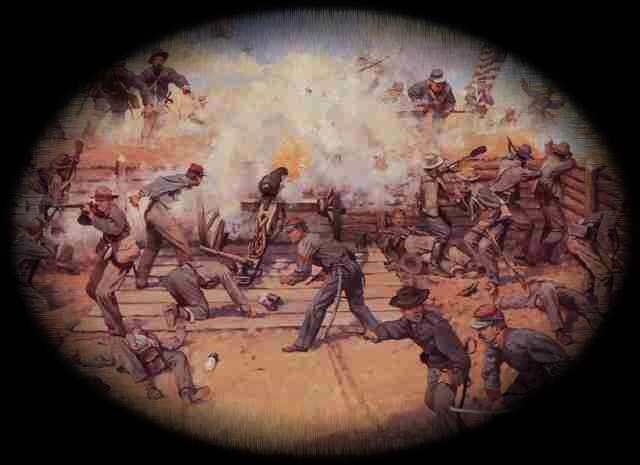
"Don't surrender this fort!"
Confederate General Nathaniel H. Harris
The Defense and Capture of Fort Greg
Colonel Thomas O. Osborn's brigade of Ohio, Pennsylvania, and Illinois troops led the Federal advance from Hatcher's Run toward Petersburg and the redefined limits of the Sixth Corps Breakthrough. Osborn, a thirty-two-year-old Chicago lawyer, had helped recruit the 39th Illinois at the outset of the war, one of the four regiments now moving northeast behind the conquered Confederate earthworks. Until this day, Osborn's only prominent action during nearly four years of service had been his participation in Benjamin Butler's attack on Drewry's Bluff in May 1864, during which a wound had cost the colonel the use of his right arm. The events of April 2 would soon replace Drewry's Bluff as the most important combat of Osborn's military career.
Osborn's offensive sprang from General Ord's 6:50 a.m. directive that Twenty-fourth Corps commander John Gibbon send all available manpower to assist the Sixth Corps. Osborn's troops found themselves at the head of Robert S. Foster's division, the brigades of Cols. George B. Dandy and Harrison S. Fairchild falling into column behind Osborn. The Chicagoan's route took him along the captured Confederate works to the vicinity of the Pickrell House where, at approximately 8:30 a.m., his regiments gained Boydton Plank Road, about the same time that Brig. Gens. Lane and Thomas were driving against Joseph Hamblin's brigade near the Banks House. Colonel William B. Curtis's and Lt. Colonel Andrew Potter's brigades of John W. Turner's Twenty-fourth Corps division used a different path to support Hamblin, traveling behind the original Sixth Corps lines toward the Union signal tower near Fort Fisher.
Osborn learned of the Confederate counterattack while en route to the scene of the Breakthrough. The brigade commander promptly ordered his troops to adopt the "double-quick" and deployed the 62nd Ohio as skirmishers. Osborn then established a line of battle, forming the 199th Pennsylvania on the right with their right flank resting on the former Confederate fortifications, the 67th Ohio in the center, and his own 39th Illinois on the left. Dandy and Fairchild would form on Osborn's left once they arrived.
Cadmus M. Wilcox, from his vantage point near Fort Gregg, could see Osborn's developing formation and recognized that a new crisis confronted his overmatched Confederate forces. As Wilcox pondered how his scattered and outnumbered troops might deal with this impending Federal threat, Col. Charles S. Venable of General Lee's staff galloped up with welcome news. Brigadier General Nathaniel H. Harris's Mississippi brigade of William Mahone's Third Corps division had crossed the Appomattox River and would arrive near Fort Gregg in a matter of minutes. Venable no sooner completed his report than Harris's small contingent appeared. Wilcox ordered the Mississippians to move westward along Boydton Plank Road and present a line of battle to the approaching bluecoats, with skirmishers in advance. "It was [my] purpose to delay the forward movement of the enemy as much as possible," explained Wilcox, "in order that troops from the north side of the James river might arrive and fill the gap between the right of our main Petersburg lines and the Appomattox."
Harris guardedly advanced his undersized brigade, guiding on Boydton Plank Road. "We found everything in confusion," testified one of the Mississippians. "Our lines had been ruptured everywhere, and the Union troops were in possession." Harris's forces proceeded about 400 yards before deploying at right angles to the highway. "The ground being undulating, I threw back both flanks, behind the crest on which I formed, and exposed my centre in order that I might induce the enemy to believe that there was a continuous line of battle behind the ridge," wrote Harris. "The enemy were evidently misled by this device, as they made the most careful dispositions, and forming two lines of battle, advanced with the utmost caution."
From his vantage point on the little rise, Harris gained his first clear view of Osborn's brigade supported by the rest of Foster's division. "It was a grand but awful sight," thought one of the Confederates, "the Federals moving with the same precision as though on parade . . . the glint and glimmer of their guns shone like a wave of silver." Supported by a couple of artillery pieces posted in their rear, Harris's men opened a "brisk fire" on the approaching Yankees. General Harris paced behind his thin line of riflemen, encouraging them to "stand like iron, my brave boys, stand like iron." Incoming Federal fire claimed a few Mississippi victims.
This light Confederate cannonade and the appearance of Harris's brigade had a less daunting effect on the Federals than the Confederate general first assumed. Osborn quickly ordered his men to charge, causing both Harris's skirmish line and Lane's and Thomas's troops along Church Road to pull back without offering serious resistance. Harris remembered that Wilcox had instructed him "not to suffer myself to be cut off, but to hold the enemy in check as long as possible, and then fall back slowly toward Batteries Gregg and Whitworth." The Federals recaptured two twelve-pounder Napoleons that had been seized during Wilcox's recent counterattack and scooped up some two dozen prisoners who either failed or declined to make a withdrawal. An officer in the 37th North Carolina of Lane's Brigade stated that his detachment's occupation of the Church Road line lasted all of fifteen minutes. Colonel James C. Briscoe of the 199th Pennsylvania confirmed that Osborn's advance occurred about 9:00 a.m., indicating that the Federals had repaired the temporary setback experienced by Hamblin's brigade in less than an hour and with literally no loss of life.
Had Osborn been able to see the commander of the opposing Mississippi troops, he would have recognized much of himself in his Confederate counterpart. Nathaniel Harrison Harris, like Osborn, was a young lawyer in command of a brigade that included his own former regiment. Harris, a native of Natchez, Mississippi, had studied law in New Orleans before the war and relocated to Vicksburg to practice his profession. In the spring of 1861, at the age of 26, Harris raised a company of infantry that became a part of the 19th Mississippi. The youthful attorney rose through his unit's ranks to become its colonel in April 1863. Lee promoted him to brigadier general the following winter, and Harris's command was one of the two Confederate brigades to defend the Bloody Angle at Spotsylvania. The Overland Campaign and subsequent action at Petersburg had reduced Harris's four regiments to about 600 effectives by April 2.
At midnight April 1-2, Mahone had ordered Harris to place his command "in readiness to move at a moment's warning." That notice arrived just one hour later. Harris had quickly removed his brigade from its position on the south end of his division's formation north of Swift Creek in Chesterfield County, leaving about one-third of his troops to maintain the picket line. The remainder of the brigade had begun moving toward the Richmond-Petersburg Turnpike, taking with them only their rifles, canteens, and cartridge boxes to ensure the most rapid possible progress. Harris remembered that his troops displayed "fine spirits . . . marching with a quick, lively step." As the column headed south toward the Cockade City, Harris could hear the "deep, heavy and incessant roar of artillery, and the sharp rattle of musketry" that indicated to him that "a more than ordinary conflict on the lines around that devoted city" was in progress. The racket about Petersburg stood in sharp contrast to the situation along Mahone's front on Bermuda Hundred that night. "Not having heard of the disaster at Five Forks the day previous, we could not imagine the cause of the alarm, as everything was perfectly quiet on our front," recalled Pvt. Thomas T. Roche of the 16th Mississippi.
By sunrise, Harris's four Mississippi regiments, the 12th, 16th, 19th and 48th, had arrived near Petersburg. They made their way up the left bank of the Appomattox River toward and across the pontoon bridge near the village of Matoaca, the hard marching column stretching out for nearly half a mile. "I met Gen. Lee a short distance from the bridge, mounted and accompanied by several members of his staff," remembered Harris. "I at once reported to him for orders." The general-in-chief asked one of his aides if Maj. Gen. John B. Gordon's line south and east of Petersburg had managed to remain intact. Learning that it had, Lee directed Harris's welcome, if modest, reinforcements toward Boydton Plank Road with instructions to report to General Wilcox "near the Newman House." This had been Harris's camping ground during the winter, so the young brigadier knew the area intimately. Harris reported to Wilcox within two hours of arriving on the south side of the Appomattox. The division commander, having already sent Lane and Thomas forward to dislodge Hamblin, appeared to Harris as being "without an organized command." Another Mississippian thought the dismounted Wilcox to be "inclined to be a little profane that morning," because the general observed enthusiastically that each of the Mississippians was "equal to one hundred of those d----d cowardly fellows." Harris advanced his brigade as Wilcox indicated, but upon the approach of Osborn's bluecoats, the Mississippi brigadier realized "the futility of attempting to check the advancing lines of the enemy with my small force (about four hundred men) in such an exposed position, [so] I fell back to the vicinity of the Newman House, where I again met Wilcox."
General Wilcox went about the business of forging a new defense with the minimal resources available to him. He positioned fragments of Lane's and Thomas's men in the sunken reaches of Boydton Plank Road facing south and extending east to Rohoic Creek, where they connected with the thinly deployed Tarheels of Brig. Gen. William R. Cox's Brigade. Wilcox placed still other Georgians and North Carolinians south of the Plank Road near the creek itself, while about 125 of Lane's and Thomas's much-traveled veterans reported to Fort Greg. Here they joined a handful of former artillerists who had been converted to infantrymen and sent to Fort Gregg a few days earlier.
This Confederate bastion and its sister strong point, Fort Whitworth, squatted about one mile west of the Dimmock line on the north side of Boydton Plank Road. Lee had ordered these outworks constructed in the fall of 1864, when he extended his main defense line from Battery 45 southwest to Hatcher's Run. The engineers had positioned the small forts so they could arrest the advance of enemy forces toward Petersburg or the Appomattox River should the primary works be breached. A lesser emplacement, styled Fort Owen in honor of Lt. Col. William Miller Owen, an artillery officer from Louisiana who was in command of the forts, lay just south of Fort Gregg a quarter mile beyond Boydton Plank Road.
The Twenty-fourth Corps troops began to deploy for the offensive on a low ridge some 800 yards south of Fort Gregg. Osborn's brigade, advanced beyond its comrades as a result of its morning foray, established position first. Colonel Osborn shook out the 62nd Ohio as brigade skirmishers, the Buckeyes approaching to within 150 yards of Fort Gregg, where they halted in a small ravine. The rest of the brigade remained on the higher ground as the balance of Foster's division formed for the assault.
Dandy's brigade filed in on Osborn's immediate left. Colonel Dandy placed the 11th Maine on the left of the brigade formation on Boydton Plank Road southwest of Fort Gregg. The 100th New York and 10th Connecticut formed successively to the right of the Pine State men, making connection with Osborn's troops. Two companies from the 11th Maine, supplemented by troops from other regiments in the brigade, advanced as skirmishers, Dandy's men deploying about 12:15 p.m. Prior to the assault, Dandy sent word to Lt. Col. Jonathan A. Hill, commanding the 11th Maine, to shift farther right in order to improve his connection with the 100th New York. For reasons that eluded the brigade commander, Hill instead took his regiment out of formation to the left and halted among the abandoned Confederate winter camps opposite Fort Whitworth. Foster's main battle line thus consisted of the four regiments of Osborn's brigade and the 100th New York and 10th Connecticut of Dandy's command.
Colonel Fairchild's brigade of Foster's division and two brigades of Turner's division supported Osborn and Dandy. Fairchild's troops occupied the ground to the left and slightly to the rear of Dandy's regiments. Behind them the veterans of Andrew Potter's and William B. Curtis's brigades moved northward from the main Union line. The third of Turner's brigades, the West Virginians of Thomas Harris's command, reported to Foster for orders. The Hoosier general directed Harris to take position on the far left of the corps, opposite Fort Whitworth. By 1:00 p.m., all six brigades of Gibbon's corps were on the field, glaring across a few hundred yards of open, intermittently swampy ground at the twin mounds of earth and logs that stood between them and Petersburg.
The troops in forts Gregg and Whitworth, outnumbered by the assembled Federals in their immediate front by a margin of eight or nine to one, had not been idle while Gibbon prepared his assault. Nathaniel Harris had sent incendiaries to torch the cabins west of Fort Whitworth, built by his own troops as winter quarters but now promising shelter to the potential attackers. While these structures burned and smoldered, the Mississippians and their comrades busily collected and loaded the extra rifles that had been either abandoned during the morning's actions or warehoused in the forts. Many of these Confederates had defended the Bloody Angle at Spotsylvania the previous spring and recalled how critical spare weapons had been. The garrison positioned extra boxes of rifle ammunition along the parapet as well. Defenders might have been in short supply; firearms and bullets were not.
With the removal of the artillery from Fort Whitworth, only the two rifles in Fort Gregg, supplemented ineffectively by ordnance in Battery 45 on the inner Confederate line, aided the outnumbered foot soldiers. In fact, Harris believed that the act of removing the artillery from Fort Whitworth precipitated Gibbon's decision to launch his assault.
Although such an explanation appears nowhere in the Union commander's accounts, there can be no question that the appearance of Foster's division, with Turner's in close proximity, etched an indelible picture in the minds of many Southern soldiers. "Ah, what a contrast, what a soul-sickening spectacle to behold," thought one member of the 16th Mississippi. "25,000 men, flushed with recent victory, to be hurled against 250 . . . half-starved heroes, whose hearts of steel qualled not even at such fearful odds." While this witness's estimate of the blueclad force exceeded a reality sufficiently daunting to require no exaggeration, a less emotional participant recalled that "Gibbon's columns approached in fine order, and by its numbers alone, seemed about to envelop the works." Harris once again exhorted the men in Fort Whitworth to "stand like iron, my brave boys, stand like iron," while Capt. R. R. Applewhite of the 12th Mississippi used much the same language to encourage the defenders in Fort Gregg. Colonel Duncan provided more specific instructions to his expectant troops, ordering them not to fire until told to do so. "All around the walls of Fort Gregg was the cry of the officers, ‘Keep down men, keep down' with their suspension drawn to a tension indescribable," remembered one Mississippian.
The Federals who entered Fort Gregg were appalled at the vision that greeted them. "The interior of the fort was a pool of blood, a sight which can never be shut from memory," testified a New Yorker. "The rebels had recklessly fought to the last." Amidst the unspeakable horror of this sickening spectacle, the surviving Confederates dropped their rifles, raised their arms, and finally acknowledged defeat. "When we rushed over the top the sight was truly terrific," remembered a Union officer. "Dead men and the dying lay strewn all about, and it was with the greatest difficulty that we could prevent our infuriated soldiers from shooting down and braining all who survived of the stubborn foe." A Confederate participant agreed that some infuriated Yankees continued their detail of death even after the garrison had capitulated:
QUOTE: Many of our captors were under the influence of whisky, and all were exasperated that we should have made such a stubborn fight, entailing on them a bloody massacre, when resistance was useless and vain. So the cry was kill, and but for their officers, who with cocked pistols made the men desist, all of us would have been murdered, and then too the jam of men in the fort gave us some protection, for it was impossible almost to shoot a Confederate without hitting a Federal. We lost about forty men killed in the fort after its capture, and fully that many Federals were killed by their own men.
Colonel Curtis reported that Capt. William A. Smiley of the 12th West Virginia accepted the formal surrender of Fort Gregg, tendered by Colonel Duncan. Smiley asked Duncan why the garrison had continued to fight once the outcome of the uneven contest had been determined. The Mississippi officer explained that the noise inside Fort Gregg had been so intense and that his men were so excited that he could not make his wishes to surrender the fort heard until the Federals had physically subdued his troops. Another member of the 12th West Virginia offered a different if implausible explanation for the Confederates' incredible fortitude: "They had been drinking whisky and gunpowder."
******* Visit the Headquarters at:
The Mississippi Central Railroad Campaign Home Page
Copyright January 2002, by Don Sides, Coffeeville, MS. Special and exclusive permission given to my good friend Ron Wallace, 4th Illinois scholar, to use on his award winning web site, "Home of the 4th Illinois Cavalry."
For the most extensive collection of 4th Illinois Cavalry information please visit Ron's site at:
Visit donsides.com for more information about Mississippi in the Civil War. (Due January 10, 2002.)
ronwally@yahoo.com

